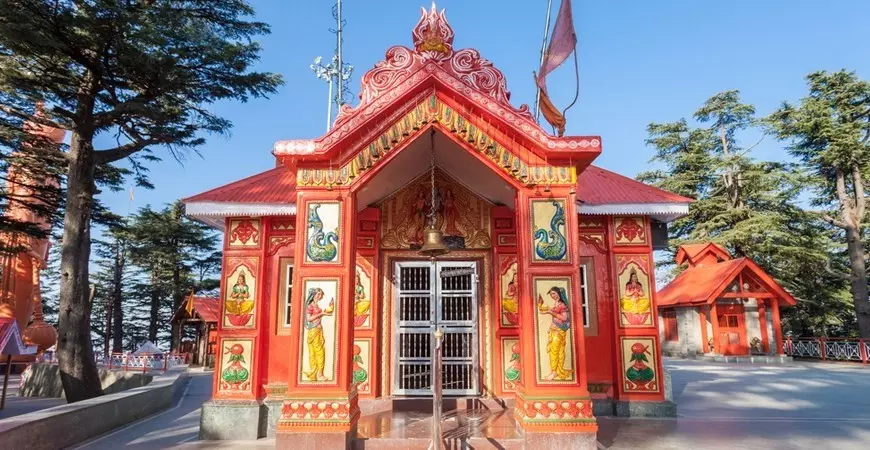
Hanuman Jayanti: 7 most famous Hanuman temples in India; what sets them apart?
On the auspicious occasion of Hanuman Jayanti, here are seven magnificent and most popular Hanuman temples in India

Devotees celebrate Hanuman Jayanti as it marks the birth of Hanuman as per the Hindu calendar. Hanuman is one of the pre-eminent mythological heroes of the epic Ramayana.
According to Vedic Astrology, Lord Hanuman’s devotees are protected from the negative influences of Shani Grah (the planet Saturn). And, praying to Lord Hanuman is believed to be the most effective way to please Shani and Mangal. Hanuman Jayanti is observed with lot of service and devotion by people from all walks of life and in particular by Hanuman Bhakts.
On this auspicious occasion, The Federal lists seven magnificent and most popular Hanuman temples in India:
1) Jakhoo temple in Shimla: Located at a height of 8,100 ft, and nestled amid the Shivalik hill ranges, Jakhoo Temple is an ancient Hanuman temple. It is believed to date back to the time of the Ramayana, built when Hanuman visited the spot to rest while searching for the Sanjeevani herb to revive an injured Lakshman. That’s probably why, the temple has a mystical feel.
What's unique: The temple has the world’s largest statue of God Hanuman, around 108 ft tall. It is believed the temple still carries the footprints of Hanuman and the monkeys that stay around the shrine are the descendants of Lord Hanuman.
2) Sankat Mochan Hanuman Temple, Varanasi: Situated by the Assi river in Varanasi, Sankat Mochan Hanuman Temple is the holiest Hanuman temples in India.
This famous temple is visited by tens and thousands of Lord Rama and Hanuman devotees, every year.
The present-day temple was constructed by Pandit Madan Mohan Malviya, a freedom fighter and the founder of BHU (Banaras Hindu University).
What's unique: According to the history of the temple, it is believed that Tulsidas, who composed the Ramacharitamanas, the story of Rama, built a statue of Hanuman underneath a sacred fig tree in the 16th century. Since then, this place has come to be known as Sankat Mochan Hanuman.
3) Shri Bala Hanuman Temple of Jamnagar: Established by Prem Bhushanji Maharaj in 1963-64.
What's unique: Since August 1, 1964, 'Sri Ram, Jai Ram, Jai Jai Ram' is being continuously chanted here night and day. It has been listed in the Guinness Book of World Records for this feat..
4) Bade Hanuman ji temple: Believed to exist from the time of the Ramayana, this temple is located at Sangam (where rivers Ganga, Yamuna and Saraswati meet) area of Allahabad, Uttar Pradesh.
As the idol is so large, the temple is called bade (big) Hanumanji Temple. What’s unique: The 20 feet long and 8 feet wide statue is found underground and in a reclining position, hence called lete(lying down) Hanuman’ Mandir. Half the idol is immersed in water. It is believed that the water of the river Ganga rises to touch the feet of the Lord Hanuman’s idol every year
5) Nammakal Anjaneyer temple in Tamil Nadu: The temple and idols are believed to be in existence since the 5th century CE. It is believed that Lord Hanuman had an image of Lord Vishnu made of saligrama (fossilized stone) and he gave goddess Lakshmi the image to safeguard until he returned. Lakshmi placed the image at this spot and this grew into a mount before Lord Hanuman could return.
What’s unique: This Hanuman temple boasts of an 18 feet tall Hanuman statue facing the Narasimha shrine at the foothills
6) Hanumangarhi in Ayodhya: Built in the 10th century CE, it is believed that Lord Hanuman lived in a cave here and guarded Ramkot, Lord Rama’s birthplace. Devotees visit this temple before going on to Lord Rama’s temple.
What’s unique: This Hanuman temple is built like a fort with all four sides covered. In all four corners, there is a circular bastion that houses a temple of Lord Hanuman. The main temple houses an idol of Maa Anjana with Bal Hanuman sitting on her lap.
7) Panchamukhi Hanuman temple in Rameshwaram in Tamil Nadu: Situated 2 km away from the Ramanathaswamy temple, this temple too is believed to exist since the time of the Ramayana.
What’s unique: The face of the five-faced (Panchamukhi) idol of Lord Hanuman has the Lord in the middle (facing east) with Lord Narasimha (facing south), Lord Adivaraha (facing north), Lord Garuda (facing west) and Lord Hayagriva (facing the sky) on the sides.
The demon king Ravana sought the help of another demon Mayil Ravana to help him during the war. This demon disguised himself as Vibheeshana (Lord Ravana’s brother who was on Lord Rama’s side) and tricked Lord Rama and his brother Lakshmana into the patala loka to kill them. To kill Mayil Ravana, Lord Hanuman had to extinguish five lamps (some legends say five wasps) all at once and he assumed the Panchmukhi Hanuman form to accomplish this.
It is believed that the location of this temple is the place where he revealed this form.

